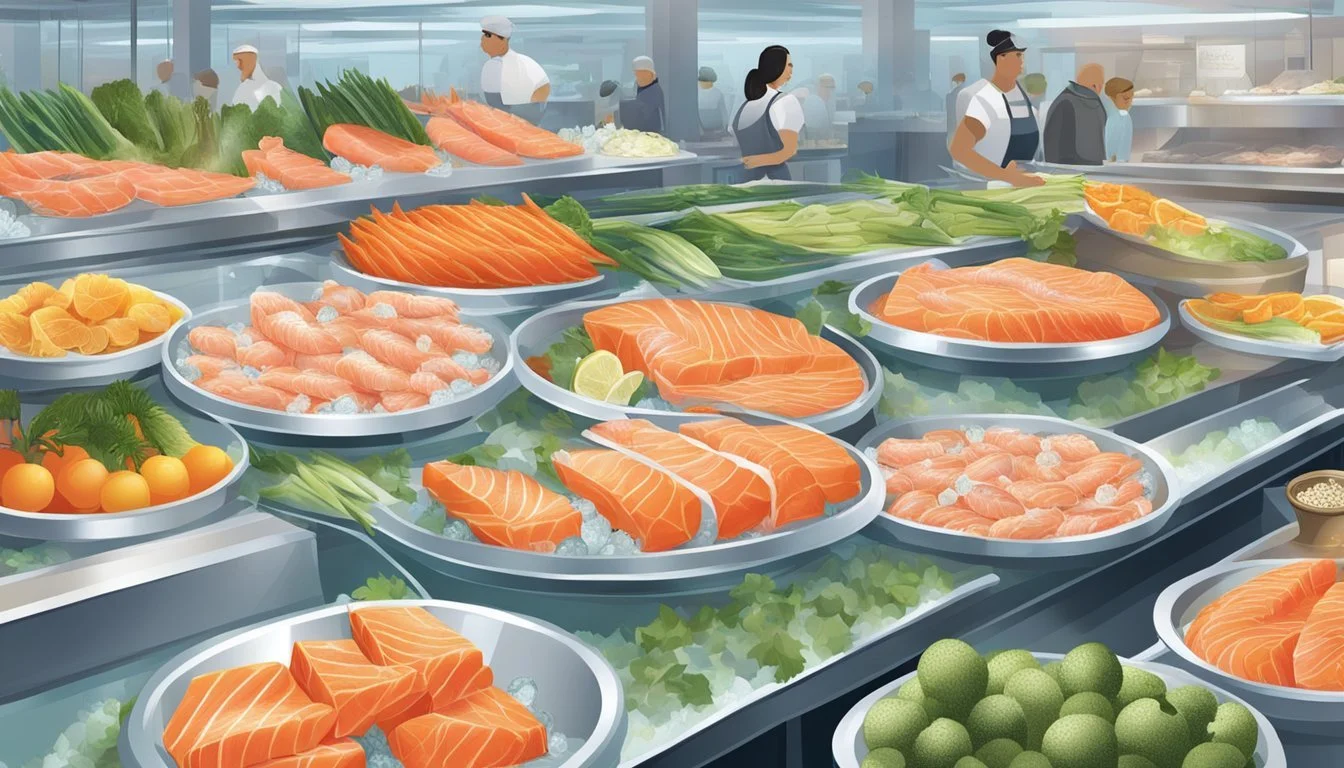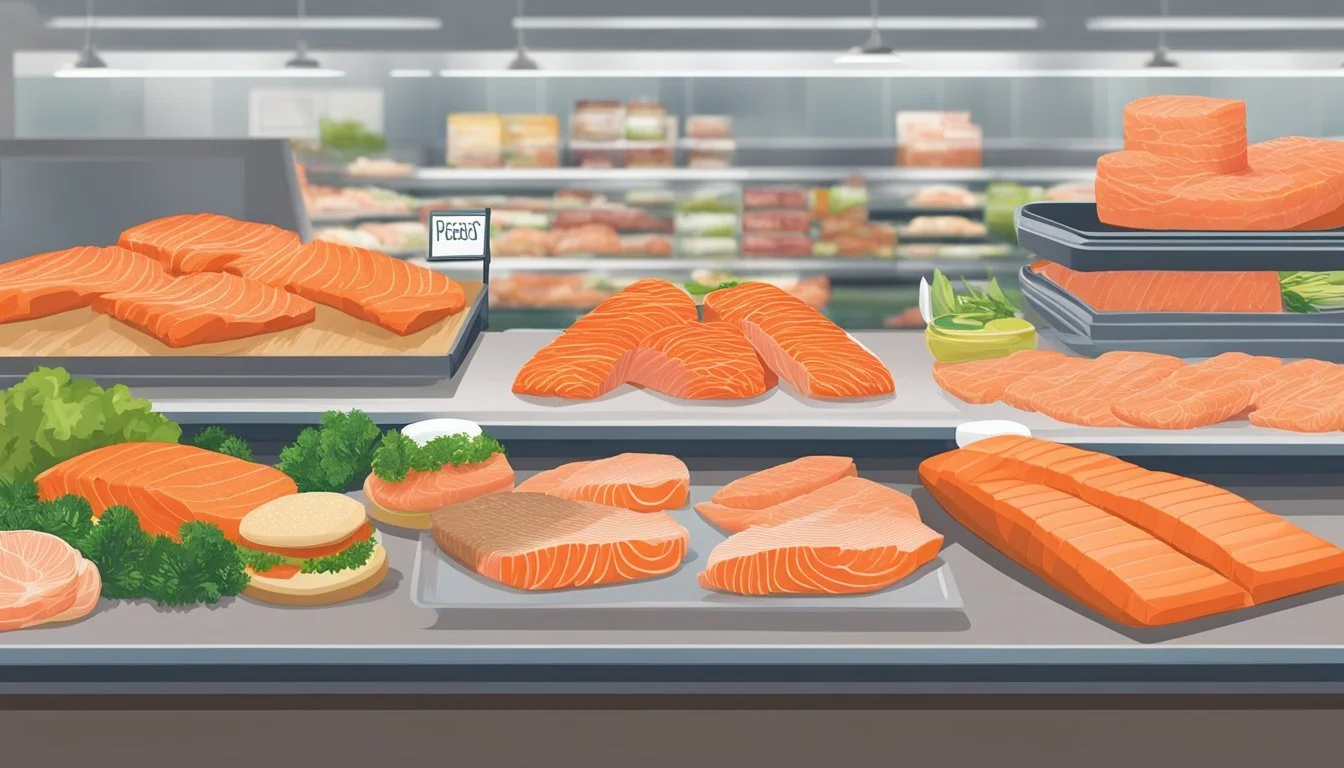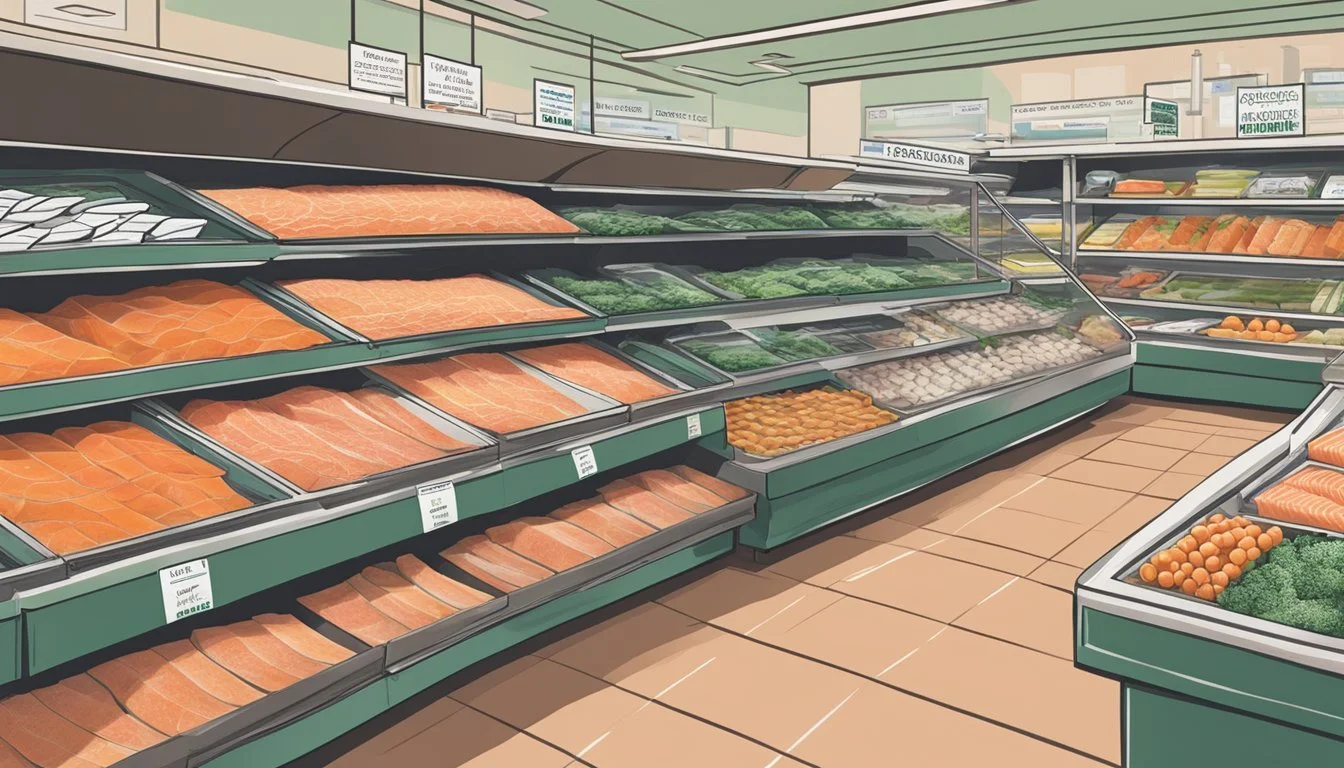Ocean to Table: Unveiling the Top Grocery Stores for Premium Fresh Salmon
Fresh salmon is a popular and nutritious choice for many consumers. Finding high-quality salmon at grocery stores can make a significant difference in taste and overall dining experience. While seafood quality can vary between retailers, some grocery chains consistently offer superior fresh salmon options.
H-E-B stands out as a top choice for fresh salmon, boasting the largest selection of locally sourced seafood from the Gulf of Mexico. This Texas-based chain has earned a reputation for excellent customer service and high-quality products. Other noteworthy contenders include Whole Foods Market and Wegmans, known for their commitment to sustainably sourced seafood and rigorous quality standards.
When shopping for salmon, consumers should consider factors such as color, texture, and origin. Wild-caught varieties like king, sockeye, and coho salmon tend to command higher prices but are prized for their flavor and nutritional value. Farm-raised Atlantic salmon offers a more budget-friendly option, typically available for $10 to $15 per pound. Regardless of the variety chosen, it's essential to purchase salmon from reputable grocery stores that prioritize freshness and proper handling.
Understanding Salmon Varieties
Salmon comes in several distinct varieties, each with its own characteristics, flavors, and culinary uses. These differences impact their availability and pricing in grocery stores.
King Salmon
King salmon, also known as Chinook, is the largest and most prized variety. It has a rich, buttery flavor and high oil content. King salmon typically weighs 20-30 pounds but can reach up to 100 pounds.
This variety is the most expensive, often costing over $25 per pound in stores. Its flesh ranges from deep red to pale pink. King salmon is ideal for grilling, broiling, and smoking due to its high fat content.
Sockeye Salmon
Sockeye, or red salmon, is known for its deep red-orange flesh and strong flavor. It's smaller than king salmon, usually weighing 5-15 pounds. Sockeye is leaner than king salmon but still has a high oil content.
In grocery stores, sockeye typically costs $15-$20 per pound. Its firm texture makes it excellent for grilling and roasting. Sockeye is also popular for canning due to its rich color and flavor.
Coho Salmon
Coho, also called silver salmon, has a milder flavor and medium fat content. It usually weighs 8-12 pounds and has bright red flesh. Coho is less oily than king or sockeye salmon.
Pricing for coho is similar to sockeye, around $15-$20 per pound in stores. Its delicate flavor makes it versatile for various cooking methods, including poaching and baking.
Pink Salmon
Pink salmon is the smallest Pacific salmon species, typically weighing 3-5 pounds. It has light-colored, soft flesh and a mild flavor. Pink salmon is the most abundant variety.
It's often the least expensive salmon in grocery stores. Pink salmon is commonly used for canning and is a good choice for salmon patties or casseroles due to its mild taste and soft texture.
Chum Salmon
Chum salmon, also called keta or dog salmon, is known for its pale to medium-colored flesh and lower oil content. It typically weighs 8-15 pounds and has a milder flavor than other Pacific salmon.
Chum is less common in grocery stores but can be found at lower prices. It's often used for smoking or in processed salmon products. Chum roe is highly valued in some markets.
Atlantic Salmon
Atlantic salmon is the most common farmed salmon variety. It has a mild, delicate flavor and soft, flaky texture. Farm-raised Atlantic salmon typically weighs 8-12 pounds.
In U.S. grocery stores, Atlantic salmon is usually farm-raised and priced between $10-$15 per pound. Its consistent availability and affordable price make it a popular choice for everyday meals.
Determining Freshness and Quality
Selecting fresh, high-quality salmon requires attention to key visual and tactile cues. The texture, color, moisture, and flavor all provide important indicators of freshness.
Texture and Color
Fresh salmon should have a firm, resilient texture that springs back when pressed gently. Avoid fish that feels mushy or leaves an indentation. The flesh should appear moist and glossy, not dry or dull.
Color is a crucial freshness indicator. Look for vibrant pinkish-orange hues in salmon fillets. Pale or grayish coloration often signals older fish. Wild salmon tends to have deeper red tones than farmed varieties.
Inspect the skin as well. It should be silvery and metallic-looking, not dull or slimy. Check for any discoloration or brown spots, which may indicate spoilage.
Moisture and Flavor
Fresh salmon should feel slightly moist to the touch, but not wet or slimy. Excess liquid in the packaging can indicate thawed fish or poor handling.
A mild, clean scent is ideal. Avoid salmon with a strong fishy odor, which suggests it's past its prime. Fresh fish should smell like the ocean, not overly pungent.
For optimal flavor, choose salmon with visible fat marbling throughout the flesh. This intramuscular fat contributes to a rich, buttery taste and moist texture when cooked.
Ask to smell the fish if possible. A sweet, cucumber-like aroma is a good sign of freshness in salmon.
Selecting Sustainable Seafood
Choosing sustainable seafood helps protect ocean ecosystems and fish populations. Look for specific labels and certifications when shopping for salmon and other seafood products.
Sustainability Labels
The Marine Stewardship Council (MSC) label indicates wild-caught seafood from well-managed fisheries. MSC-certified salmon comes from stocks that are not overfished.
Seafood Watch, run by the Monterey Bay Aquarium, provides color-coded ratings. Green "Best Choice" options are the most sustainable. Yellow "Good Alternative" seafood is the next best option.
Some retailers use their own sustainability labels. Safeway and other stores have adopted responsible sourcing policies for their seafood departments.
Environmental Certifications
The Aquaculture Stewardship Council (ASC) certifies responsibly farmed seafood. ASC-certified salmon farms limit environmental impacts.
Best Aquaculture Practices (BAP) is another certification for farmed seafood. It covers food safety, environmental, and social responsibility.
GlobalG.A.P. certifies aquaculture facilities that follow good practices. This includes limiting antibiotics and protecting surrounding ecosystems.
Some salmon producers use multiple certifications. Look for products with both ASC and MSC labels for the highest standards.
Evaluating Grocery Stores and Retailers
When seeking fresh salmon, the quality of a store's seafood department and its sourcing policies are crucial factors to consider. These elements can significantly impact the taste, freshness, and sustainability of the salmon you purchase.
Seafood Department Quality
Whole Foods and Wegmans consistently rank high for their seafood departments. These stores often feature extensive selections of fresh salmon, including various species and cuts. Their fish counters are typically staffed by knowledgeable employees who can provide information on sourcing and preparation methods.
Costco, while known for bulk purchases, also maintains a reputation for high-quality fresh salmon at competitive prices. Their seafood sections often offer both farmed and wild-caught options.
Publix and Sprouts Farmers Market are recognized for their commitment to freshness and variety in their seafood departments. These stores frequently source locally when possible, enhancing the likelihood of obtaining recently caught salmon.
Retailer Seafood Policies
Many grocery chains have implemented sustainability and social responsibility policies for their seafood sourcing. Whole Foods follows strict standards, refusing to sell overfished species or those from poorly managed fisheries.
Kroger has committed to sourcing 100% of its wild-caught seafood from fisheries that are Marine Stewardship Council (MSC) certified or in Fishery Improvement Projects. They also work towards ensuring their farmed salmon comes from Best Aquaculture Practices (BAP) certified sources.
Walmart, despite being a mass retailer, has made efforts to improve its seafood sustainability. They aim to source all fresh and frozen wild-caught seafood from MSC certified fisheries or those involved in Fishery Improvement Projects.
Aldi has partnered with the Sustainable Fisheries Partnership to enhance the sustainability of its seafood supply chain, focusing on both wild-caught and farmed fish sources.
Health Benefits and Nutritional Information
Salmon offers numerous health benefits due to its rich nutrient profile. It provides high-quality protein, essential vitamins, and heart-healthy fats.
Omega-3 Fatty Acids
Salmon is an excellent source of omega-3 fatty acids, particularly EPA and DHA. A 3.5-ounce (100-gram) serving of salmon contains approximately 2.3 grams of these beneficial fats. Omega-3s play crucial roles in:
• Reducing inflammation • Supporting brain function • Promoting heart health • Improving eye health
Regular consumption of salmon may help lower the risk of cardiovascular disease and support cognitive function. The American Heart Association recommends eating fish rich in omega-3s, like salmon, at least twice a week.
Fat Content and Saturated Fat
Salmon provides healthy fats while being relatively low in saturated fat. A 3-ounce (85-gram) serving of salmon contains:
• Total fat: 5.4 grams • Saturated fat: 1 gram
The majority of fat in salmon comes from heart-healthy monounsaturated and polyunsaturated fats. These fats can help improve cholesterol levels when consumed as part of a balanced diet.
Salmon's low saturated fat content makes it a favorable protein choice for those monitoring their saturated fat intake. The American Heart Association recommends limiting saturated fat to less than 6% of total daily calories.
Preparation and Cooking Tips
Proper preparation and cooking techniques are essential for enjoying delicious salmon at home. From simple recipes to choosing between frozen and fresh options, mastering these skills will elevate your salmon dishes.
Salmon Recipes
Grilled lemon-herb salmon is a classic choice. Brush fillets with olive oil, sprinkle with lemon juice, dill, and garlic. Grill for 4-5 minutes per side. For a quick meal, try pan-seared salmon. Heat oil in a skillet over medium-high heat. Cook skin-side down for 4 minutes, flip, and cook 2-3 minutes more.
Baked salmon en papillote is an easy, flavorful option. Place salmon on parchment paper with vegetables, herbs, and a splash of white wine. Fold into a packet and bake at 400°F for 12-15 minutes.
Poaching salmon yields tender results. Bring water, white wine, and aromatics to a simmer. Add salmon and cook for 8-10 minutes until opaque.
Frozen vs Fresh Options
Fresh salmon offers superior texture and flavor but requires quick use. Look for bright, firm flesh with no strong odors. Fresh-caught salmon is ideal but often more expensive and less readily available.
Frozen salmon provides convenience and consistent quality. It's often frozen shortly after catching, preserving freshness. Thaw in the refrigerator overnight before cooking. Some frozen options are individually vacuum-sealed, maintaining quality for months.
Pre-portioned frozen fillets are great for meal planning. They're typically more affordable than fresh options. For best results, avoid refreezing thawed salmon.
Different Forms of Salmon Products
Salmon is available in various convenient forms at grocery stores. These options cater to different preferences and cooking needs, providing flexibility for consumers.
Canned Salmon
Canned salmon offers a shelf-stable option for quick meals. It typically comes in two varieties: pink and sockeye. Pink salmon has a milder flavor and softer texture, while sockeye boasts a richer taste and firmer consistency.
Canned salmon is pre-cooked and packed in water or oil. It's a versatile ingredient for salads, sandwiches, and pasta dishes. Some brands offer boneless and skinless options for easier preparation.
Look for low-sodium varieties if watching salt intake. Canned salmon retains its nutritional value, providing omega-3 fatty acids and protein.
Salmon Burgers
Pre-made salmon burgers offer a convenient alternative to traditional beef patties. These are typically found in the frozen section of grocery stores.
Salmon burgers are made from minced salmon, often mixed with seasonings and binders. They come in various flavors, such as lemon-dill or teriyaki. Some brands use wild-caught salmon, while others opt for farm-raised.
These burgers cook quickly, making them ideal for weeknight dinners. They can be grilled, pan-fried, or baked. Serve on a bun with toppings or crumbled over salads for a protein boost.
Frozen Salmon Options
Frozen salmon provides a longer-lasting option without sacrificing quality. Many grocery stores offer individually vacuum-sealed portions for easy thawing and cooking.
Flash-frozen salmon is caught and frozen quickly, preserving its freshness and nutritional content. This process helps maintain the fish's texture and flavor.
Options include skinless fillets, skin-on fillets, and salmon steaks. Wild-caught varieties like sockeye and coho are often available alongside farm-raised Atlantic salmon.
Frozen salmon can be thawed overnight in the refrigerator or quickly under cold running water. It's suitable for various cooking methods, including baking, grilling, and pan-searing.
Responsible Consumer Practices
Consumers play a crucial role in promoting sustainable seafood practices. When buying salmon, shoppers should seek out stores that participate in responsible seafood programs.
Many retailers collaborate with organizations like the Environmental Defense Fund and Gulf of Maine Research Institute to ensure their seafood is sustainably sourced. These partnerships help prevent overfishing and protect marine ecosystems.
The Ocean Disclosure Project provides transparency about seafood sourcing. Consumers can check if their preferred stores participate in this initiative.
Look for labels like Open Nature, which indicate responsibly sourced seafood. These products often come from well-managed fisheries or environmentally conscious farms.
Before purchasing, ask store staff about the origin of their salmon. Responsible retailers should be able to provide this information readily.
Choose varieties that are not overfished. Wild Alaskan salmon is generally a sustainable option, while some farmed salmon can have environmental impacts.
By making informed choices, consumers can support retailers that prioritize responsible seafood sourcing. This encourages more stores to adopt sustainable practices, benefiting marine ecosystems in the long run.






